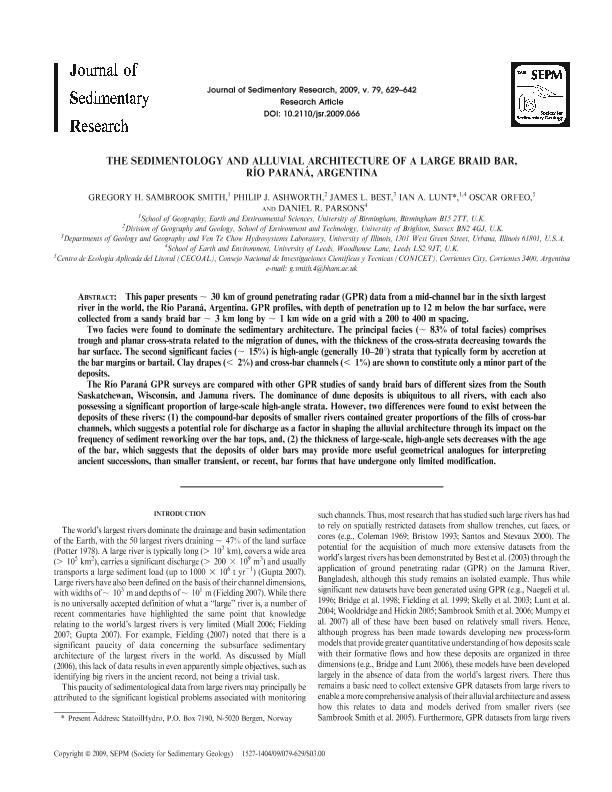Artículo
The sedimentology and alluvial architecture of a large braid bar, Río Paraná, Argentina
Sambrook Smith, Gregory H.; Ashworth, Philip J.; Best, James L.; Lunt, Ian A.; Orfeo, Oscar ; Parsons, Daniel R.
; Parsons, Daniel R.
 ; Parsons, Daniel R.
; Parsons, Daniel R.
Fecha de publicación:
07/2009
Editorial:
Society for Sedimentary Geology
Revista:
Journal of Sedimentary Research - (Print)
ISSN:
1527-1404
e-ISSN:
1938-3681
Idioma:
Inglés
Tipo de recurso:
Artículo publicado
Clasificación temática:
Resumen
This paper presents ∼ 30 km of ground penetrating radar (GPR) data from a mid-channel bar in the sixth largest river in the world, the Rio Paraná, Argentina. GPR profiles, with depth of penetration up to 12 m below the bar surface, were collected from a sandy braid bar ∼ 3 km long by ∼ 1 km wide on a grid with a 200 to 400 m spacing. Two facies were found to dominate the sedimentary architecture. The principal facies (∼ 83% of total facies) comprises trough and planar cross-strata related to the migration of dunes, with the thickness of the cross-strata decreasing towards the bar surface. The second significant facies (∼ 15%) is high-angle (generally 10-20°) strata that typically form by accretion at the bar margins or bartail. Clay drapes (< 2%) and cross-bar channels (< 1%) are shown to constitute only a minor part of the deposits. The Río Paraná GPR surveys are compared with other GPR studies of sandy braid bars of different sizes from the South Saskatchewan, Wisconsin, and Jamuna rivers. The dominance of dune deposits is ubiquitous to all rivers, with each also possessing a significant proportion of large-scale high-angle strata. However, two differences were found to exist between the deposits of these rivers: (1) the compound-bar deposits of smaller rivers contained greater proportions of the fills of cross-bar channels, which suggests a potential role for discharge as a factor in shaping the alluvial architecture through its impact on the frequency of sediment rew orking over the bar tops, and, (2) the thickness of large-scale, high-angle sets decreases with the age of the bar, which suggests that the deposits of older bars may provide more useful geometrical analogues for interpreting ancient successions, than smaller transient, or recent, bar forms that have undergone only limited modification.
Palabras clave:
Alluvial Architecture
,
Large Braid Bar
,
Río Paraná
Archivos asociados
Licencia
Identificadores
Colecciones
Articulos(CECOAL)
Articulos de CENTRO DE ECOLOGIA APLICADA DEL LITORAL (I)
Articulos de CENTRO DE ECOLOGIA APLICADA DEL LITORAL (I)
Citación
Sambrook Smith, Gregory H.; Ashworth, Philip J.; Best, James L.; Lunt, Ian A.; Orfeo, Oscar; et al.; The sedimentology and alluvial architecture of a large braid bar, Río Paraná, Argentina; Society for Sedimentary Geology; Journal of Sedimentary Research - (Print); 79; 8; 7-2009; 629-642
Compartir
Altmétricas



